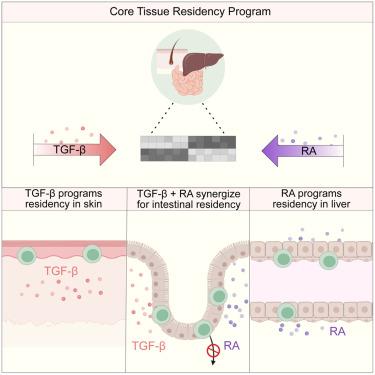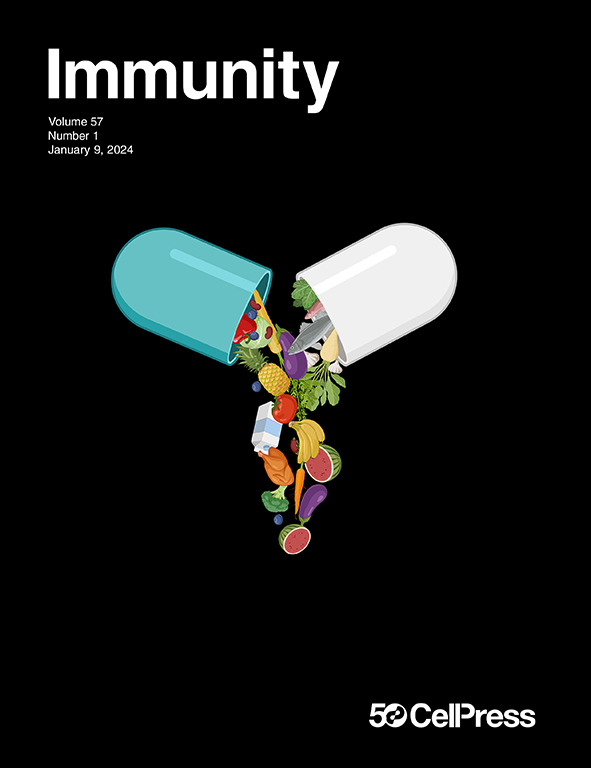维甲酸和 TGF-β 协调器官特异性组织驻留程序
IF 25.5
1区 医学
Q1 IMMUNOLOGY
引用次数: 0
摘要
组织驻留记忆 T(TRM)细胞是组织免疫不可或缺的一部分,它们持续存在于不同的解剖部位,在那里它们遵循共同的转录框架。人们对这些细胞如何整合不同的局部线索以采用共同的TRM细胞命运仍然知之甚少。在这里,我们发现皮肤TRM细胞严格需要转化生长因子β(TGF-β)才能在组织中驻留,而其他部位的TRM细胞则利用代谢产物视黄酸(RA)来驱动另一种分化途径,在肝脏中引导不依赖于TGF-β的组织驻留程序,并与TGF-β协同驱动小肠中的TRM细胞。我们发现,肠道 TRM 群体的长期维持需要 RA,部分原因是 RA 阻碍了它们的逆向迁移。此外,增强的 RA 信号调节了 TRM 细胞的表型和功能,这一现象反映在微生物多样性增加的小鼠身上。总之,我们的研究结果揭示了 RA 是宿主与环境相互作用的基本组成部分,它引导着组织中的免疫监视。本文章由计算机程序翻译,如有差异,请以英文原文为准。

Retinoic acid and TGF-β orchestrate organ-specific programs of tissue residency
Tissue-resident memory T (TRM) cells are integral to tissue immunity, persisting in diverse anatomical sites where they adhere to a common transcriptional framework. How these cells integrate distinct local cues to adopt the common TRM cell fate remains poorly understood. Here, we show that whereas skin TRM cells strictly require transforming growth factor β (TGF-β) for tissue residency, those in other locations utilize the metabolite retinoic acid (RA) to drive an alternative differentiation pathway, directing a TGF-β-independent tissue residency program in the liver and synergizing with TGF-β to drive TRM cells in the small intestine. We found that RA was required for the long-term maintenance of intestinal TRM populations, in part by impeding their retrograde migration. Moreover, enhanced RA signaling modulated TRM cell phenotype and function, a phenomenon mirrored in mice with increased microbial diversity. Together, our findings reveal RA as a fundamental component of the host-environment interaction that directs immunosurveillance in tissues.
求助全文
通过发布文献求助,成功后即可免费获取论文全文。
去求助
来源期刊

Immunity
医学-免疫学
CiteScore
49.40
自引率
2.20%
发文量
205
审稿时长
6 months
期刊介绍:
Immunity is a publication that focuses on publishing significant advancements in research related to immunology. We encourage the submission of studies that offer groundbreaking immunological discoveries, whether at the molecular, cellular, or whole organism level. Topics of interest encompass a wide range, such as cancer, infectious diseases, neuroimmunology, autoimmune diseases, allergies, mucosal immunity, metabolic diseases, and homeostasis.
 求助内容:
求助内容: 应助结果提醒方式:
应助结果提醒方式:


